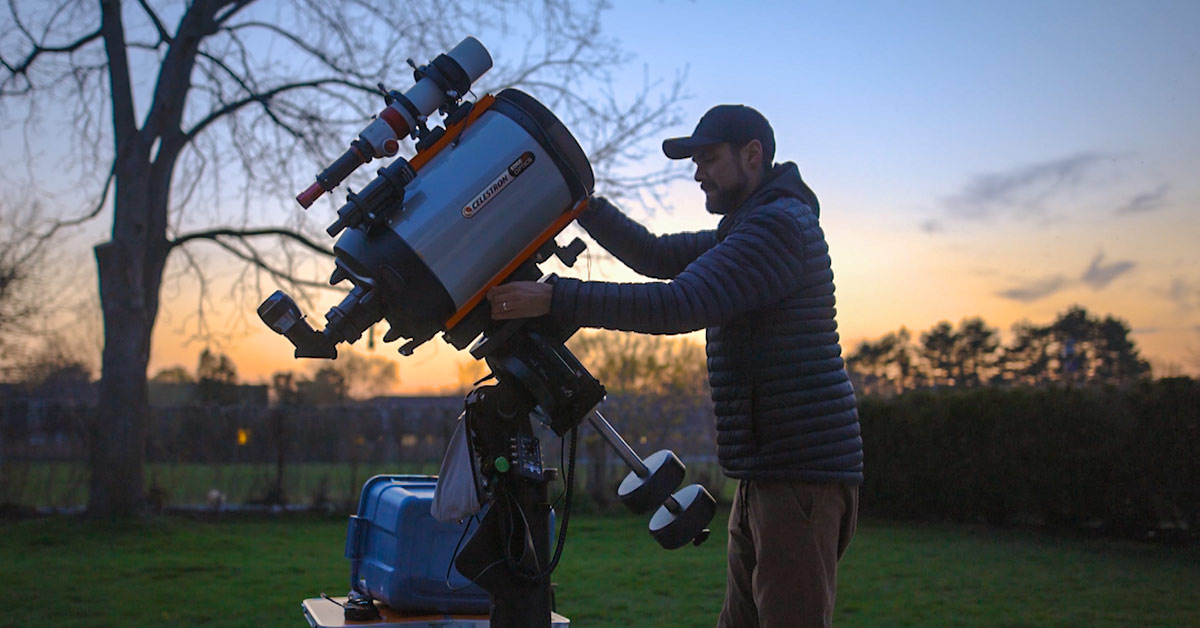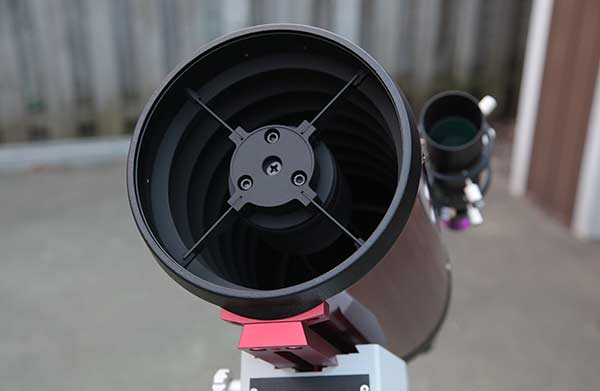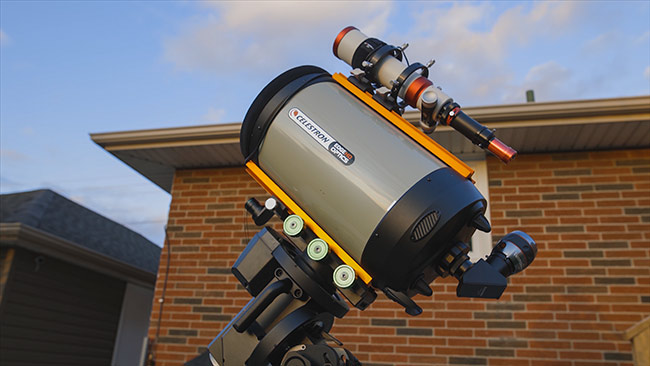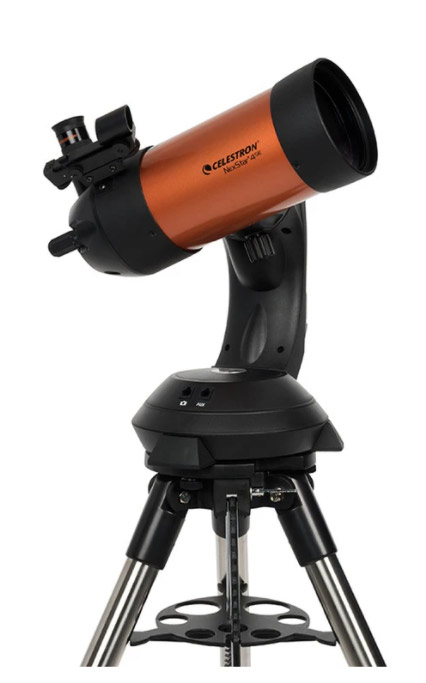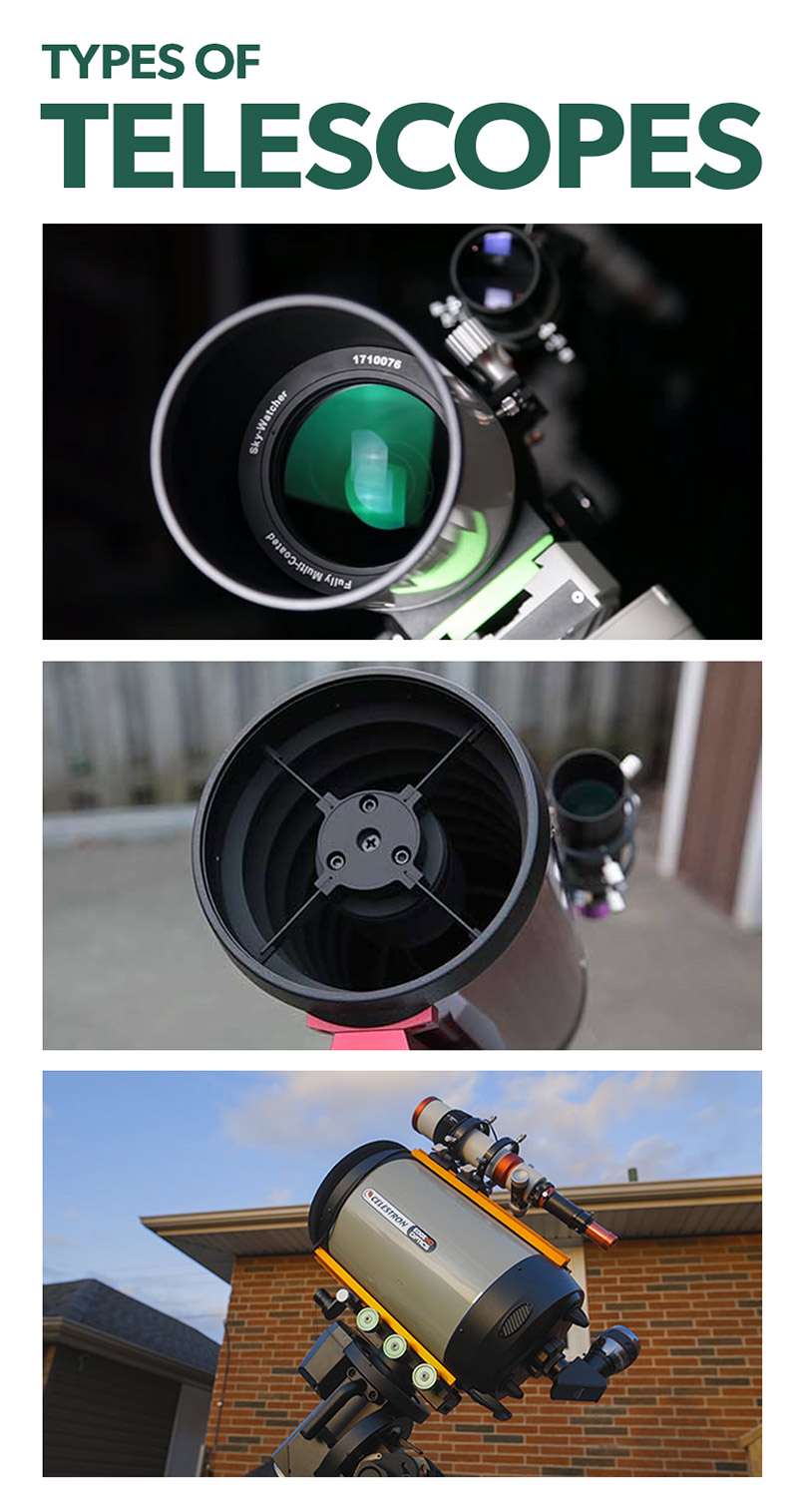Types of Telescopes
This article was last updated on December 11, 2024.
The Basic Types of Telescopes
There are many different types of telescopes available for those interested in exploring the night sky. Telescopes come in a variety of designs, some of which have been around since the 1600s.
The first type of telescope ever designed was a refractor, designed by an eyeglass maker in the Netherlands in 1608. Soon after, Galileo improved on this refracting telescope design and applied its uses to astronomy.
The three main types of telescopes are refracting telescopes, reflecting telescopes, and catadioptric telescopes. Each type has many variations and hybrid designs.
I consider a Dobsonian Reflector to be the best telescope type for a beginner due to its combination of ease of use, function, and affordability. For astrophotography purposes, a compact apochromatic refractor is best.
A Dobsonian telescope with a healthy aperture (8″ is perfect) is great for exploring the sky and enjoying real-time views of the brighter objects in the sky, while a refractor telescope is best used with a camera attached, to photograph faint deep-sky objects.
Setting up my Schmidt-Cassegrain telescope for a night of astrophotography.
If you are a beginner and looking to purchase your first telescope, it is recommended that you have a clear vision of what you want to use it for (e.g., visual, photography, planetary, deep-sky, etc.), your available budget, and the level of complexity you want to take on for your equipment set-up.
Related Post: How to Use Your First Telescope
The main goal of any astronomical telescope is to gather light. People often focus on the telescope’s magnification, which is actually less important than the instrument’s ability to collect more light than the observer’s unaided eye can.
When choosing a telescope, many different characteristics come into play, but arguably, the two most important factors will be your desired focal length and aperture.
You can think of the telescope’s focal length as its ‘magnification’ of the sky and how big an object will appear. The aperture will determine how bright the object will appear, as a larger diameter telescope can gather more light at once.
An 8-inch Dobsonian Telescope with a focal length of 1200mm at F/5.9.
What is The Best Telescope?
I am a full-time astrophotographer, and I have used many different types of telescopes to both view and photograph the wonders of the night sky. Unlike the other articles littered across the web explaining that the ‘best telescope’ is the one they recommend on Amazon, I have some honest advice for you.
Keep in mind that this is from the perspective of a backyard stargazer who primarily focuses on deep-sky astrophotography but also likes to visit a star party or two for the visual experience. The following suggestions are for those looking to view objects in space through a telescope.
If you are primarily interested in capturing images through your telescope, check out my list of best astrophotography telescopes.
Which telescope is best for seeing planets?
If you are interested in viewing the solar system planets up close, you’ll want a telescope with plenty of aperture. A Dobsonian telescope with a mirror of at least 8″ is a great choice, but 10″ or 12″ is even better.
If you want to photograph planets in detail, a high magnification, large aperture telescope like a Schmidt-Cassegrain is tough to beat. These telescopes can be mounted to a tracking equatorial mount, to precisely track the movement of the planets across the sky.
What is considered the best telescope?
Determining the “best” telescope depends on your personal observing preferences, goals, and budget. However, when people ask me this, I often suggest an 8″ Dobsonian telescope because it offers one of the best user experiences for the price.
Reflector telescopes offer larger apertures for the price, resulting in deeper, more detailed views of the planets, the moon, and even deep-sky objects such as galaxies and nebulae. See my review of the Apertura AD8 Dobsonian Reflector as a fantastic example of this type of telescope.
Which is the best telescope to view galaxies?
Because most galaxies appear small and dim from our vantage point on Earth, telescopes with larger apertures are recommended because they collect more light. Newtonian reflectors are a great choice for those on a budget and can pull in some tremendous details on the brightest galaxies in the night sky.
The largest galaxies can be seen in almost any telescope, under the right conditions. For example, my first successful photograph of the Andromeda Galaxy was captured using a compact refractor telescope with an 80mm aperture. However, viewing galaxies through the eyepiece of a telescope like this is not ideal.
If you are looking for the ultimate viewing experience, a Dobsonian telescope with an aperture of 12″ or more will show fainter objects than most other telescopes. The telescope shown below (Sky-Watcher FlexTube 350P) is the biggest visual telescope I have ever used, and I was able to see more galaxies in this telescope than any other model I own.
A 14″ Dobsonian telescope for viewing galaxies.
Which telescope to see Saturn’s rings?
Witnessing Saturn’s iconic rings through a telescope is one of the most memorable astronomy experiences one can have. While almost any telescope is capable of viewing the planet Saturn, to observe them in detail, a telescope with moderate to high magnification is recommended.
A telescope with an aperture of at least 150mm (6″) and a focal length of 1000mm+ is recommended to view Saturn’s Rings in detail. A computerized tracking telescope mount will make it easier to stay focused on the planet for longer periods of time.
In the video below, you can watch me photograph the planet Saturn through my Celestron Edge HD 11 telescope in the backyard.
What is the best telescope for moon gazing?
The moon is probably the easiest thing to see through a telescope, and it never disappoints. With its captivating craters and various moon phases, viewing the lunar landscape up close is a favorite target for many stargazers.
Any astronomical telescope (unless it’s broken) is suitable for viewing the moon. However, a well-corrected refractor telescope will likely provide the most crispy views. A mid-range apochromatic refractor telescope with an aperture of 100mm will provide sharp, detailed views of the moon.
If it’s detailed lunar surface photos you’re after, a larger telescope such as a Newtonian Reflector or Schmidt-Cassegrain is best. An aperture of 10″ or more will reveal countless craters on the moon’s surface that you can observe in detail.
The full moon captured through a 150mm refractor telescope.
Key Telescope Specifications:
- Focal Length (Magnification)
- Focal Ratio (Light Gathering Ability
- Aperture (Size of Objective Lens/Primary Mirror)
The focal length determines your field of view and will impact how far you will be able to see through your telescope and aperture will determine how much light you will capture and the level of detail.
These two factors will create a unique viewing experience based on the type of experience you are looking for. Below are the three main types of telescopes, including the advantages, disadvantages, and a few examples of each type of telescope that I have experience with.
As an astrophotographer first, a visual astronomer second, I understand the confusion that some folks have about choosing their first telescope. Unfortunately, there is no one-size-fits-all telescope for great visual observations, and practical astrophotography too.
In the video below, I discuss the type of telescope I would recommend for a complete beginner (a manual Dobsonian reflector).
Refractor Telescopes
A refractor telescope has a glass objective lens as the main focusing unit to collect light at the front of a long tube. This lens is usually made up of two or more lens elements where light is bent (or refracted), as it passes through the tube, to produce a clear image and reduce distortion.
In the past, I have written about my thoughts on using a refractor for astrophotography and that I think it is the best choice to get started in deep-sky astrophotography.
Modern refractor/refracting telescopes come in two styles: achromatic and apochromatic. Each of these styles is designed to reduce chromatic aberration (i.e. color fringing or color distortion/dispersion) differently, which is a common problem in lenses (i.e. refractors) when colors are refracted/bent incorrectly.
The William Optics RedCat 61 is an excellent refractor telescope for astrophotography.
This happens because the lens is either unable to bring all wavelengths of color to the same focal plane and/or when they are focused at different areas on the focal plane and causes a mismatch in color at the focal point.
There are ways to reduce chromatic aberration. One method is to use multiple compensating lenses to counteract chromatic aberration. Another method is to use a long objective focal length (distance between the focus and the objective) to minimize the effect.
Apochromatic refractors (apochromat) have objectives built with special, extra-low dispersion materials. They are designed to bring three wavelengths (typically red, green, and blue) into focus in the same plane. The residual color error (tertiary spectrum) can be down to an order of magnitude less than that of an achromatic lens.
Such telescopes contain elements of fluorite or special, extra-low dispersion (ED) glass in the objective and produce a very crisp image that is virtually free of chromatic aberration. Due to the special materials needed in the fabrication, apochromatic refractors are usually more expensive than telescopes of other types with a comparable aperture.
Advantages of Refractor Telescopes
Although you have to deal with chromatic aberration, refractor telescopes can be more reliable. After the initial alignment, their optical system is more resistant to misalignment than that of a reflector telescope.
The glass surface inside the tube is also sealed from the atmosphere protecting it from dust and other lens disturbances, reducing the need to clean the lens.
High-quality refractors can also provide crisp, high-contrast images with high magnification, making refractors a great telescope for astrophotography and planetary/lunar observing.
They are usually much smaller and more portable than other types of telescopes too. This means that you will not require a large equatorial telescope mount as you would for some of the larger telescope types.
The Sky-Watcher Esprit 100 ED APO.
Refracting telescopes I have used:
- William Optics RedCat 51
- William Optics RedCat 61
- William Optics Zenithstar 73 APO
- Sky-Watcher Esprit 100 ED APO
- Explore Scientific ED80
- Explore Scientific ED102
- Explore Scientific ED140 APO
A refractor telescope is my top choice when it comes to your first astrophotography telescope. The compact size, crisp optics, and wide-field imaging possibilities are perfect for newcomers.
Downsides of a Refractor Telescope:
Although refractor telescopes are portable, durable, and don’t require a lot of maintenance compared to other types of telescopes. they do have a few downsides to consider:
- Chromatic Aberration: Refractor telescopes are known for producing chromatic aberration, which is a type of distortion that results in different colors of light not being focused on the same point. This can result in purple fringing or halos around bright objects in the image.
- Wide Field of View: The field of view of a refractor telescope is relatively wide compared to other types of telescopes. The largest refractor telescope I own has a focal length of just 1050mm.
- Expensive: High-quality refractor telescopes can be quite expensive, especially when compared to reflector telescopes of the same aperture.
These downsides can be mitigated by using a high-quality apochromatic refractor telescope, which is designed to reduce chromatic aberration. Additionally, a field flattener can help to improve the final image quality.
Reflector Telescopes
Unlike a refractor, a reflector telescope uses mirrors (that bend inward) to reflect light that has traveled down a tube, into a secondary mirror near the top of the tube directing light into the eyepiece.
A reflector telescope is said to be the best value for your money, as they offer the most aperture for your dollar. For example, a 6-inch diameter refractor telescope can cost up to 10X as much as a 6-inch Newtonian reflector.
Related Article: How Much Does a Telescope Cost?
Many reflector/reflecting telescopes are great for viewing planets (such as Mars, Jupiter, or Saturn) and the simplistic design makes them easy to build and also means they are often very affordable.
The most common form of this telescope is the Newtonian reflector, which was (you guessed it) invented by Isaac Newton.
A Newtonian reflector includes a curved, dish-shaped primary mirror to collect light at the bottom of the telescope. At the top of the telescope, a small diagonal secondary mirror directs the light from the primary mirror to the eyepiece, found on the side of the telescope.
Looking through a Newtonian Reflector telescope on a Dobsonian mount.
The use of inward-bent mirrors in place of a glass lens also eliminates chromatic aberration as wavelengths reflect off the mirror to a single point.
The objective mirror on a reflector is supported along the back end of the telescope so the mirrors can be made very large. Compared to a refractor of the same size, a reflector telescope is cheaper to make and can therefore be cheaper to purchase.
I consider a Dobsonian mount design to be the best telescope for beginners. It offers a large aperture with plenty of light-gathering ability, a practical format for viewing, and an affordable price tag.
Newtonian reflectors work well at focal ratios from f/4 to f/8, and unlike a refractor telescope, can provide a wide field of view relative to its aperture.
A few disadvantages with this type of telescope are that they can easily fall out of alignment (collimation), and with an exposed/wide-open tube, the optics need frequent cleaning.
With a secondary mirror used to redirect the light into a more convenient viewing spot, this mirror can produce diffraction effects.
Reflecting telescopes I have used:
- Sky-Watcher Heritage 130mm
- Apertura AD8 Dobsonian Reflector Telescope
- Orion 8” f3.9 Newtonian Astrograph
My 8″ Orion Newtonian Reflector Telescope.
What is Collimation?
In general, reflector telescopes require more upkeep and maintenance than other telescope designs. Reflectors must be regularly collimated to perform at their optimal ability.
The process of collimating a reflector telescope involves precisely aligning the mirrors in the telescope using specialized, simple tools. A laser collimator is a handy tool to consider purchasing if you own a reflector telescope.
The diagram below displays what you see through a collimating eyepiece down a reflector’s focuser tube.
How to Collimate Your Newtonian Reflector Telescope (Sky and Telescope).
Ritchey-Chrétien Telescopes
Ritchey Chretién telescopes (RC’s) use a two-mirror design to bring an image into focus. This mirror system places the RC telescope in the reflector category.
RC’s are fantastic telescopes for long focal length astrophotography of distant, small objects in the night sky. In fact, the Hubble Space Telescope is a Ritchey Chretién.
The iOptron Photron RC6 (Ritchey Chretién).
The secondary mirror in a Ritchey Chretién is held up by four struts (spider vanes), just like a Newtonian telescope. This creates diffraction spikes in the bright stars of an astrophoto, which most agree adds to the appeal of the image.
The Ritchey-Chrétien design is designed to offer a coma and chromatic aberration-free experience thanks to their well-corrected optics.
In late 2018, I had an opportunity to test my first Ritchey Chrétien telescope (iOptron Photron RC6). By design, this catadioptric telescope uses hyperbolic primary and secondary mirrors.
What is an RC Telescope? Discussion on Quora.
Catadioptric Telescopes
A catadioptric (or compound) telescope, uses both lenses and mirrors. The greatest appeal of this type of telescope is that they are very compact with their tubes two to three times as long as wide.
The result is that you can obtain a large-aperture, long-focus telescope that’s very transportable. This type of telescope does need occasional optical collimation, but this is not something I have ever experienced myself.
The image below shows an 11-inch Schmidt-Cassegrain telescope with a native focal length of 2800mm at F/10. Thanks to its large aperture and long focal length (high magnification), this is the telescope I use to photograph planets in impressive detail.
My Celestron Edge HD 11 Schmidt-Cassegrain Telescope.
Similar to refractors, the tubes for these telescopes are seal to keep out dirt and dust, which is a big plus especially if you are in an environment prone to these types of conditions.
To handle dew/moisture, a lens hood (dew shield) can help to prevent moisture from accumulating on the exposed corrector plate.
A Schmidt-Cassegrain (such as a Celestron C8, C11, etc.) is a catadioptric telescope that combines a Cassegrain reflector’s optical path with a Schmidt corrector plate to make a compact astronomical instrument that uses simple spherical surfaces.
Catadioptric telescopes I have used:
Another catadioptric telescope widely used for astronomy is the Maksutov-Cassegrain, or “Mak” for short. Unlike refractors and reflectors, this telescope design does not suffer from coma or chromatic aberration.
These telescopes are great for lunar and planetary viewing, as well as terrestrial daytime use. The slower focal ratios of this type of telescope mean less light is reaching the eyepiece (or your camera) than some of the fast focal ratio telescopes out there.
A common “Mak-Cass” telescope on the market today is the Celestron NexStar 4SE. This is a 4″ (102mm) Maksutov-Cassegrain design in a compact, computerized (GoTo) package.
The Celestron NexStar 4SE Maksutov-Cassegrain Telescope.
Astrophotography
If deep-sky astrophotography is your goal, choosing the right telescope will depend on the types of objects you wish to shoot. I have put together a list of 10 of the best astrophotography telescopes available, all with example images I have taken with them myself.
A high-quality triplet apochromatic refractor is a great choice for large nebulae and galaxies. A long focal length SCT is a better fit for small galaxies and planetary astrophotography.
Because the moon is so big and bright, almost any telescope is suitable for photographing it. Photographing other objects in space, such as comets, star clusters, and galaxies, can be more challenging.
To capture images of space through a telescope, you must attach a camera to the telescope using the appropriate adapters.
You can also handhold your camera up the eyepiece of your telescope to take a picture of the moon or bright planets, but this method can be challenging and yield poor results.
A typical astrophotography camera and telescope setup.
The majority of the deep-sky astrophotography I have taken was using apochromatic refractor telescopes. The camera was threaded directly onto the focuser drawtube of the optical tube assembly (prime focus), utilizing the instrument’s native focal length.
This means that to photograph various objects in space (big and small), an assortment of different telescope types must be used.
Astrophotography images captured in my backyard through various telescopes.
Smart Telescopes
Smart telescopes like the ZWO Seestar S50 have now entered the amateur astronomy world and are a fantastic option. While they don’t offer the classic visual astronomy experience through an eyepiece the way traditional telescope does, they produce impressive images of objects in the night sky for you to enjoy.
They work similarly to an astrophotography setup, where an astronomy camera collects long-exposure images through a small refractor telescope. The image is then enjoyed on your smartphone or tablet with the necessary mobile app installed on your smartphone.
The Seestar S50 is an all-in-one ‘smart telescope’ that produces images of space on your smartphone.
Smart telescopes are increasingly popular because they allow the user to easily find and photograph deep-sky objects without any prior knowledge of the night sky. They are a big hit at astronomy outreach events because multiple people can enjoy views of space at once without the lineup at the eyepiece.
Related Article: Dwarf 3 Smart Telescope Review
The Bottom Line
The best type of telescope for you will depend on your intended uses. If you are a casual observer of the night sky and want a telescope that provides a painless, enjoyable experience, an 8″ Dobsonian reflector is probably your best bet.
If you’re an amateur astrophotographer like me, a compact, wide-field apochromatic refractor will likely be your most valued telescope. The design of your telescope will determine its size, magnification, focal length, and light-gathering ability.
Because these aspects change based on design, there is no “one-size-fits-all” telescope for every scenario. You may even find that a simple pair of binoculars you own are a great fit for astronomy.
With that being said, many seasoned amateur astronomers will recommend having a dedicated telescope for visual astronomy (one that is easy to transport and offers comfortable views), and one that is strictly used for astrophotography purposes.
About Me:
Trevor Jones and his wife Ashley.
I have been observing and photographing the night sky using various telescopes for over 10 years. The largest telescope I have ever observed an object in space through was a 36″ Dobsonian reflector at the Cherry Springs Star Party in 2018!

